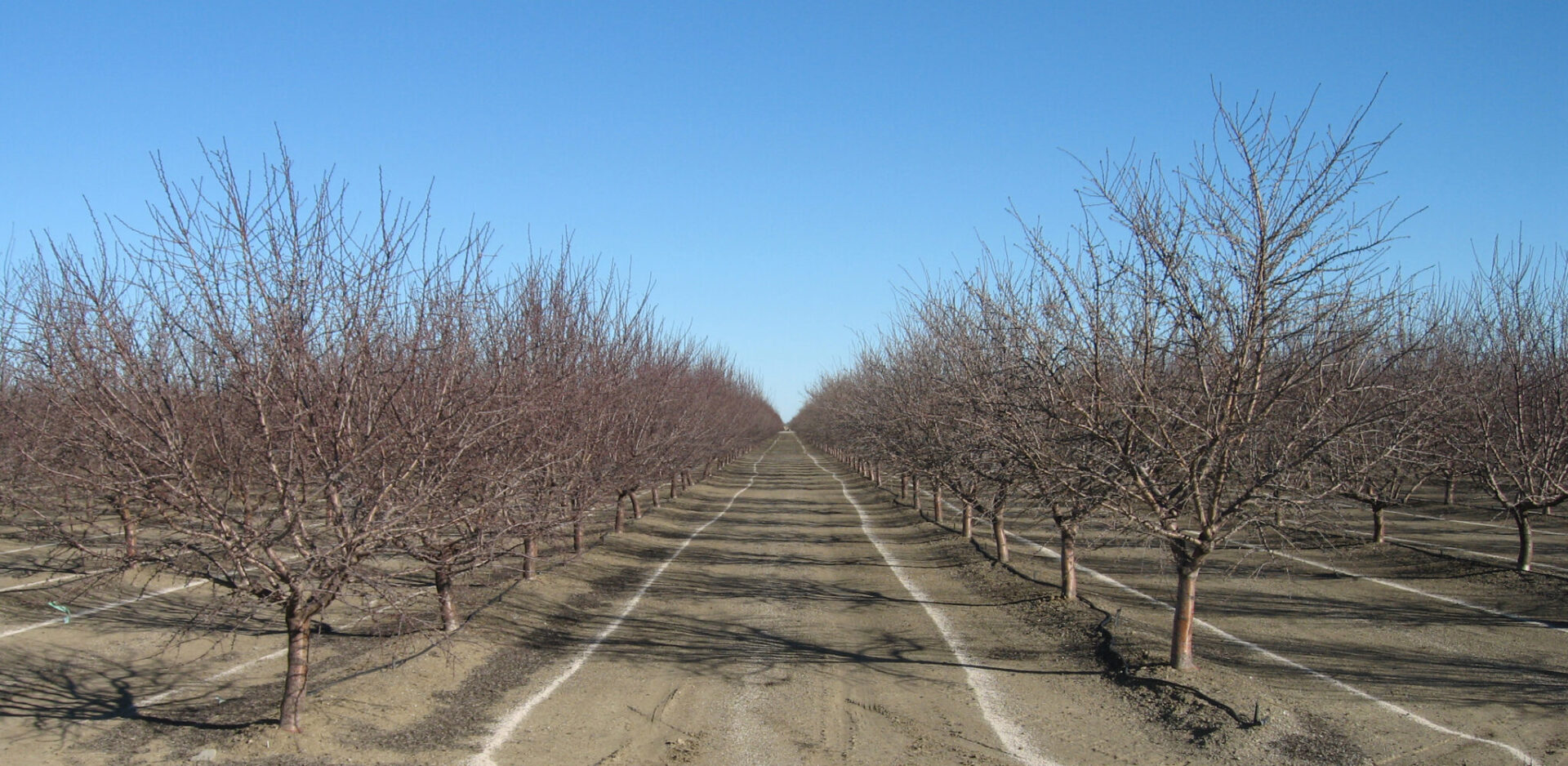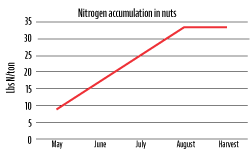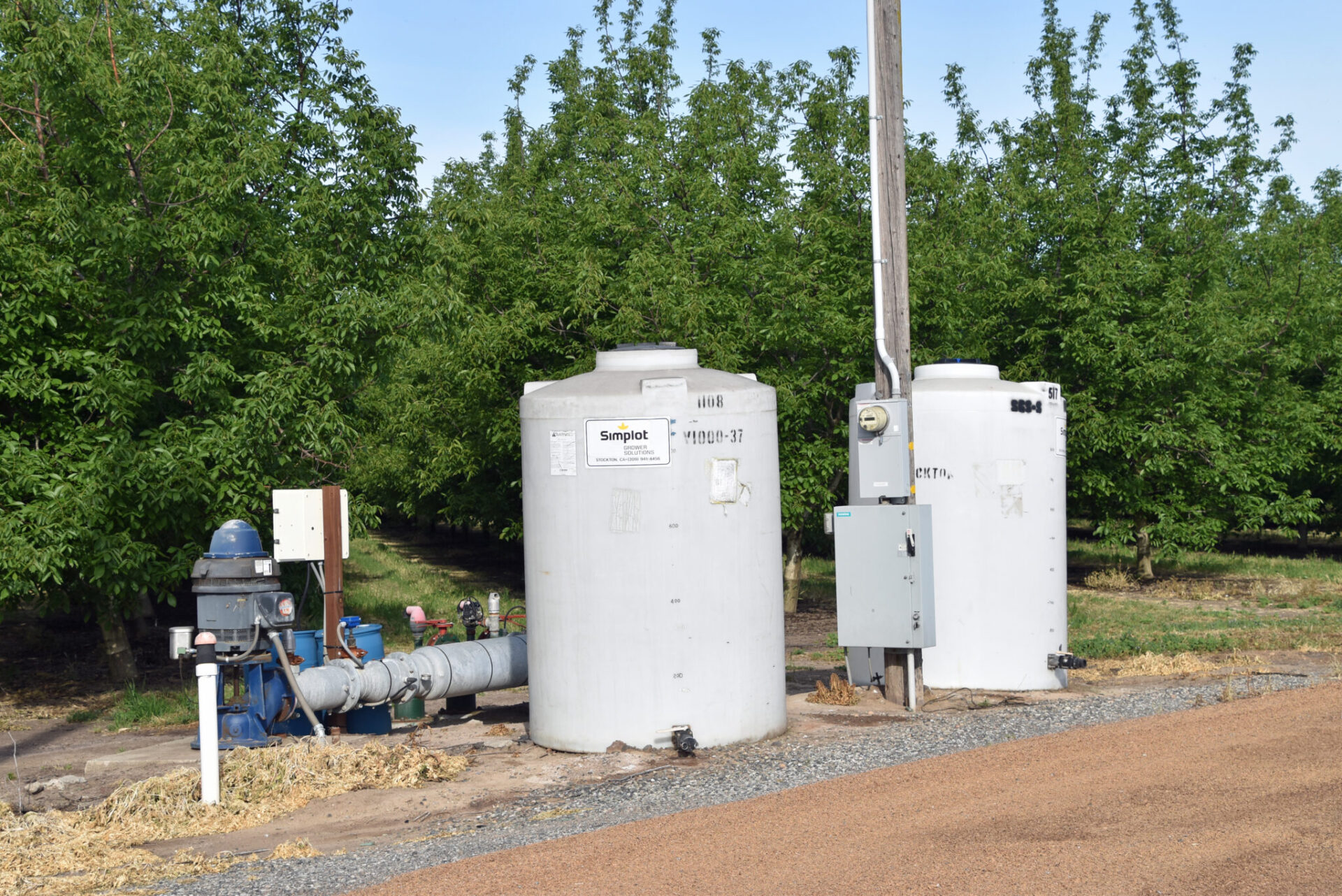
With harvest on the horizon, it’s important to keep in mind that some orchards will need a bit of extra care once the nuts are gone. Not all nut crops need postharvest nutrition, however. In this article, I discuss the four big nutrients (nitrogen, potassium, zinc and boron) in almonds, pistachios and walnuts, and whether you should be doing some post-harvest fertilization.
Potassium
Potassium is the first nutrient that I think about in nut crop postharvest nutrient management. Heavy banding of potassium on the side of a tree row is a traditional way of supplying this nutrient to the tree, where winter rains will dissolve your chosen product and move it into the soil. Once the fertilizer is dissolved and moved into the soil solution, the potassium will loosely bind to clay and soil organic matter, which protects the nutrient from leaching from soil over the winter. The ability of soils to bind onto positively charged ions (cations) is generated by clay and organic matter particles and called the Cation Exchange Capacity (CEC).
Banding works in sands, loams and clays as well as potassium-fixing soils, which are found on the eastern side of the San Joaquin Valley. Potassium-fixing soils contain clays that expand when wet and have the ability to trap small cations, such as potassium and ammonium, between them. This potassium may become available in the future; however, it is often in a longer time frame and effectively makes potassium unavailable for uptake. Heavy potassium bands will saturate the fixation capacity of a small zone of soil, and the remaining potassium as well as any future applications will be completely available for uptake.
Products like potassium sulfate and potassium chloride are typically used for banding, though potassium chloride (KCl) should not be used in orchards that get less than eight inches of annual rainfall or with wells that are already high in salts. Chloride is toxic to salt-sensitive almonds and walnuts. Even in areas that have at least that much average annual rainfall, dry winters (like our last two winters) can cause issues that erase any savings you may gain from choosing KCl.
When banding potassium, make sure to apply bands in the wetted zone of whatever irrigation system you have. Roots in microirrigated orchards are concentrated in the wetted zone, and this is the only area where water and nutrient uptake will occur during the growing season (for the most part). Any potassium that falls outside will be inaccessible to the trees.
Another way to fertilize your orchards is via fertigation. Fertigating with potassium delivers this nutrient directly, and only, to the area of nutrient uptake, and in contrast to banding, mass flow delivery of potassium will result in the lateral movement of this critical nutrient (Table 1). While the solubility of potassium products is not an issue in fall-applied bands, fertilizer solubility may be something to consider when fertigating. In general, potassium fertilizers are not very soluble; the lower the solubility, the more water you need to dissolve it. Another way to think of it: the lower the solubility, the less potassium you deliver in an acre-inch of water. Keep in mind that as soon as the potassium enters the soil, potassium acts the same, regardless of fertilizer source.

Fertigation also side-steps potassium-fixing soils, but only as long as the soil does not completely dry out. Once that happens, potassium becomes fixed. If this does happen, additional potassium applications will ensure the trees have continual supplies for uptake.
As with nitrogen, potassium application rates should reflect export rates, and it is best to manage both nutrients in the same way: yearly applications to replace what has been exported with harvest. Table 2, provides export rates for the major tree nut crops. Orchards that are deficient in potassium may need heavier applications of 100 to 200 pounds K2O (more may be needed in soils with high clay content) in addition to annual needs to allow trees to build up depleted reserves.

Boron
Boron is an interesting nutrient. On the west side of the San Joaquin Valley and in the Yolo County area, it is in excess, yet on the eastern side of the county, particularly in light-textured soils, it can be deficient. All three nut crops need it, though pistachios are particularly boron-hungry. Boron is weakly mobile in soils and is exported with the harvested crop; almonds that have adequate boron levels will export between 3.5 and 5.5 ounces of boron per 1000 kernel pounds, for example. Export rates are not available for walnut and pistachio; however, sufficiency values are available for all three crops (Table 3) and should be used when deciding whether to apply boron. It would be harmful to an orchard to apply boron in order to replace what has been exported if it is already at toxic levels.
When to time foliar boron applications is dependent on the crop. This is because boron is mobile in almonds and other Prunus species and is immobile in walnuts and pistachios. Therefore, only almonds can remobilize and store fall-applied foliar boron. Soil boron applications should be made during the growing season and likely won’t affect tree boron status until the following year.

Boron is best applied to almonds leaves in the fall just after harvest. Low rates should be applied; only one or two pounds of a 20%-boron-containing product per 100 gallons of water is needed. Spring applications to trees are also acceptable but should be applied at pink bud as later sprays may interfere with pollination. Research suggests that fall foliar sprays should be done in almonds unless a hull analysis indicates the orchard is at toxic levels.
Why do we use hulls to determine boron levels in almonds, while leaves are acceptable for all other nutrients (and to determine boron nutritional status in pistachios and walnuts?) Boron will form an association with a particular kind of sugar that almonds make and transport in the phloem: sorbitol. Because of this, boron is transported with sugars in the phloem and will end up in the location that sugars end up in, which is the fruit. Boron levels in leaves will rise and fall with plant boron status, but monitoring leaves is not as sensitive as monitoring hulls.
Applying a foliar boron spray to pistachios and walnuts is best done in spring. While fall soil applications are acceptable, they will likely not be taken up until the following spring.
Zinc
Zinc is a nutrient that is primarily deficient because of the high pH found in most Central Valley soils; above a pH of 7, as every pH unit increases by 1, zinc availability is reduced 100-fold. Because of this, soil applications are typically not used, though work done in Arizona and New Mexico suggests that soil applications of chelated zinc may be adequate to supply zinc needs to young pecan trees in high-pH soils. In California, foliar applications are standard. Fall applications can supply much of the zinc needs for Prunus species; however, work done in walnuts and pistachios shows that foliar applications should be done in the spring. Table 4, shows leaf critical values for zinc.

In the past, heavy foliar zinc applications (20 lbs. zinc sulfate per acre) were applied late in the fall, which would defoliate the trees. Work done by UCCE’s Franz Niederholzer has shown that lower rates (5 lbs. zinc sulfate) applied earlier in the fall were as effective at supplying trees with zinc while keeping leaves on the tree and allowing for photosynthesis to occur for as long as possible.
Nitrogen
Why did I place nitrogen at the end of the list when it’s the nutrient that almost everyone thinks about the most? First, there’s no evidence that postharvest fertilization in pistachios and walnuts is necessary. Work done by UCCE’s Katherine Jarvis-Shean shows that nitrogen uptake in walnuts stops after August long before harvest (Figure 1). It has been well documented that nitrogen uptake follows demand, and after harvest, there is no vegetative or reproductive growth; the trees spend their time continuing to build carbohydrate reserves, which does not directly require nitrogen.

Work done on Kerman pistachios has shown much the same as in walnuts; there’s little to no nitrogen uptake after harvest, though in an ON year, we recommend that you apply your last 20% of annual nitrogen when the nuts have reached maturity, or just after harvest if for some reason you cannot apply it earlier. It is possible that postharvest nitrogen dynamics may be different in the earlier harvesting Golden Hills and Lost Hills, and work funded by the California Pistachio Research Board, led by UCCE’s Doug Amaral and in which I am a collaborator, will seek to examine this.
Our suggestions for almond postharvest nutrition have been changing as more research has been done. Work done by Patrick Brown and Saiful Muhammad has shown that there is very little nitrogen uptake after harvest, which amounts to a measly 8% of the total annual needs. However, in the past, we’ve typically recommended that you apply 25% of the remaining nitrogen budget to make up for any additional nitrogen that may have been needed after nitrogen applications cease in June to reduce hull rot risk. But work that examined the connection between nitrogen and hull rot has shown that later applications of nitrogen aren’t the problem; rather, it is high nitrogen content in the tree (possibly from heavy early-season applications). Additionally, work done by Niederholzer at the Nickels Soil Laboratory in Arbuckle, Calif. has shown that there was no benefit to postharvest nitrogen applications in almonds. So, what should you do?
It’s important to take a few things into account when you’re deciding what to do. First, what did your July leaf tissue analysis show? If it was deficient, and/or you had a much-higher-than-predicted yield, and you have an earlier harvesting variety like Nonpareil, it may be a good idea to do a small nitrogen application right after harvest. If you have a later harvesting variety, such as Winters or Monterey, or your orchard looks extremely stressed from harvest (yellowing and senescent leaves, obvious and severe water stress during the harvest period), your trees are likely not in a state to take up nitrogen and may even be starting the dormancy process.
UC Davis’ Patrick Brown has suggested that if you spoon-feed nitrogen (apply small amounts of nitrogen every irrigation or every other irrigation from 70% leaf expansion through harvest while not exceeding annual tree nitrogen demands), there will be no need for postharvest nitrogen applications, and the risk of hull rot will be low. As far as I’m aware, this has not actually been evaluated in a commercial orchard, but it is biologically sound and worth considering. This practice has been used in Australia. If you have already been doing it, send me an email (pegordon@ucanr.edu) as I’d like to hear about your experiences.
In conclusion: postharvest nitrogen in almonds is likely not necessary, except in the case of deficient almond orchards.











